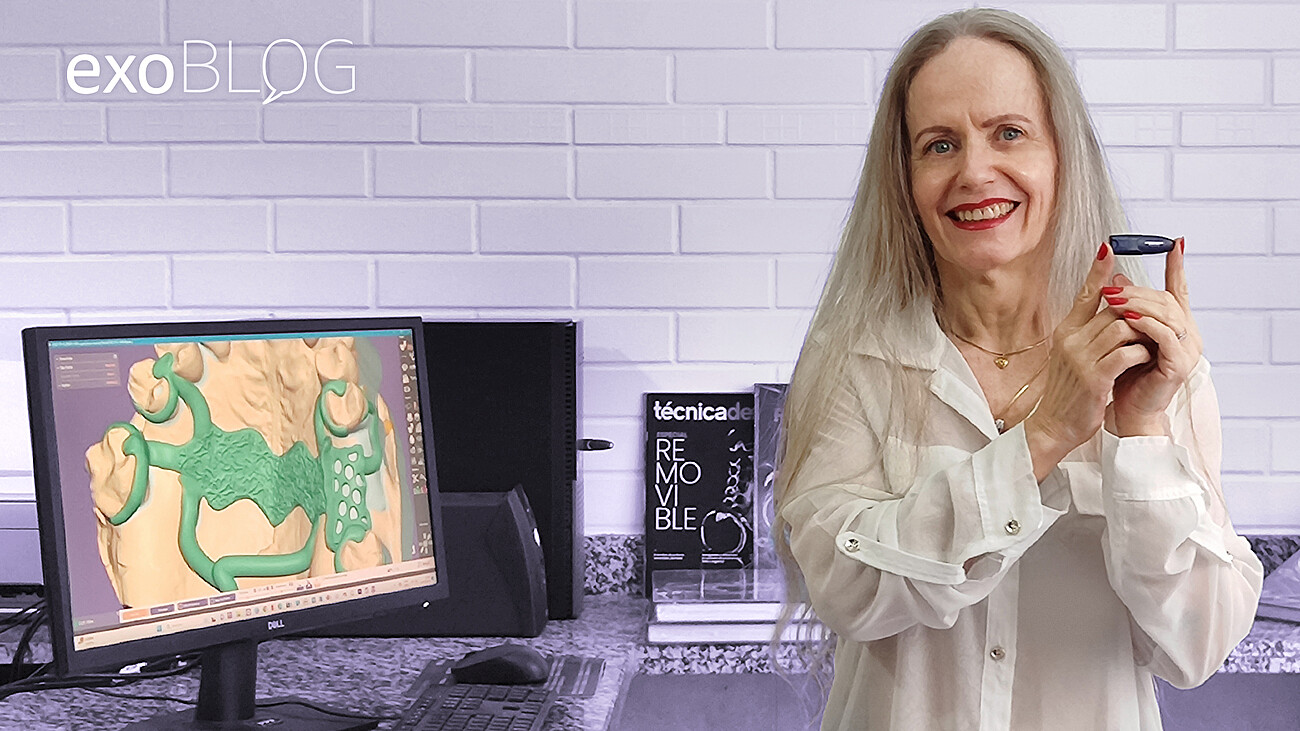The constant evolution of removable partial dentures
Renata Blümer lives and breathes removable partial dentures. The Brazilian lab tech got her start in 1995 and transitioned to a digital workflow four years ago. She says exocad’s PartialCAD is the tool she counts on to achieve the restorations she wants. Renata shares her experience with the latest release: PartialCAD 3.1 Rijeka.
Q: Please tell us a little about who you are and what you do.
A: I’m a Brazilian dental technician, specializing in partial dentures. In the lab, I always use digital workflows and follow the latest technologies. I enjoy studying the Portuguese language and writing: I have published several e-books. I also produce videos and have a YouTube channel: PPR Digital Renata Blümer. I take care of my health with a healthy diet and do weight training every day. I like to release my energy at the gym with a good workout and come home refreshed.
Q: Why did you decide to become a dental lab technician?
A: A friend, the dentist Dr. Heloisa Fleury, introduced me to a dental prosthesis course at the Unicamp Dentistry School, and to the city of Piracicaba, in the state of São Paulo. It was passion at first sight—for the course, and for the city.
Q: Tell us more about your lab. What types of restorations do you perform most often? Where is it based?
A: The laboratory is much more than just a livelihood for me. It is a source of fulfillment and is directly linked to my professional success and happiness. I work exclusively in the field of removable partial dentures since 1995 and with digital workflows since 2019. The laboratory is in the city of Piracicaba, in the interior of the state of São Paulo, the southeastern region of Brazil. My clientele covers the city of Piracicaba and the surrounding region. Now, with the advent of digital flow, we have expanded the service to other cities, states and countries.
Q: What equipment and software do you use?
A: I use the most well-known dental CAD software: exocad. In the lab, I work with a desktop computer. For courses and lectures, I carry a notebook with me. In terms of printers and scanners, I can use a range of different pieces of equipment from many manufacturers, and it is great that exocad software makes this possible.
Q: When and why did you begin using a digital workflow?
A: I started with a digital workflow at the end of 2019. Three months were enough to transition from conventional to digital. Today it is essential that prosthetic labs implement digital workflows to be able to serve modern dental practices using digital dentistry. The technological advance has brought a big change in the way we work in a dental practice. For the prosthetic laboratory and removable partial dentures, it is no different.
Q: Which exocad software do you use and why?
A: PartialCAD and DentalCAD. Soon I will add implants, models and bars. Because exocad is the best.
Q: What’s your favorite exocad software feature?
A: My favorite is all the resources in PartialCAD. My experience with exocad software inspired me to write the first book in Brazil on digital removable partial dentures. I hope this book will add value to fellow technicians, helping labs in the transition from conventional to digital removable partial dentures.
“The advantage of PartialCAD? In a few words: time optimization. This software is easy for beginners and sensational in the hands of experts.”
Q: What are the advantages and disadvantages of working in a digital workflow with PartialCAD?
A: The advantages of PartialCAD? In a few words: time optimization. This software is easy for beginners and sensational in the hands of experts. Initially, it may be a little difficult for those who, like me, were accustomed to traditional approaches and saw technology as something distant. Now, from personal experience, I can tell you: it is very easy to work with digital workflows since exocad's software is intuitive.
Disadvantages? I don't see any disadvantages.
Q: Do you have any tips on how lab techs can use exocad’s PartialCAD in their workflows?
A: I have several tips on PPRDigital on the YouTube Channel PPRDigital Renata Blümer. A refresher on the channel is planned for the year 2024, with several tips from PartialCAD 3.1 Rijeka.
Q: As someone who is very respected in the field, do you have any advice for young people, especially women, who are considering pursuing a career as a dental technician?
A: When I started in partial dentures 30 years ago, I was the only woman. I hope to encourage and inspire many others to follow the same path.
Q: What’s your favorite song at the moment?
A: “Unstoppable” by Sia.
Q: What’s your favorite tooth to design and why?
A: Canines because they tear the food.
Q: If you could give advice to your younger self, what would it be?
A: Enjoy your family before they’re gone.
Q: If exocad was an animal, what would it be?
A: An eagle.
Q: One word for exocad?
A: Sensational.
Read the interview in Portuguese here.

by Caitlan Reeg
Writer at exocad
Caitlan Reeg spends her days telling the world about the innovations her colleagues create. She’s passionate about healthcare, technology, and the ways the two interact to improve our lives. A former journalist, Caitlan has worked on staff at Dow Jones Newswires in Frankfurt and at the national public radio program Marketplace in Los Angeles.




